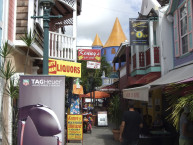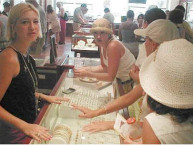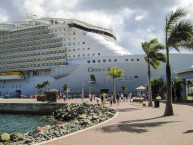Barbados
The island was uninhabited when first settled by the British in 1627. Slaves worked the  sugar plantations established on the island until 1834 when slavery was abolished. The economy remained heavily dependent on sugar, rum, and molasses production through most of the 20th century. The gradual introduction of social and political reforms in the 1940s and 1950s led to complete independence from the UK in 1966. In the 1990s, tourism and manufacturing surpassed the sugar industry in economic importance.
sugar plantations established on the island until 1834 when slavery was abolished. The economy remained heavily dependent on sugar, rum, and molasses production through most of the 20th century. The gradual introduction of social and political reforms in the 1940s and 1950s led to complete independence from the UK in 1966. In the 1990s, tourism and manufacturing surpassed the sugar industry in economic importance.
Barbados is the ‘Little England’ of the Caribbean, but not so much so that the locals have given up rotis for kidney pies, or rum for bitter ale. Bajans, as the islanders call themselves, are as West Indian as any of their neighbours, and have tended to appropriate rather than adopt English customs.
You’ll notice this the first time you check out a local cricket match, since the gentlemanly English game has a totally different rhythm here. Nonetheless, there are old stone Anglican churches in every parish, horse races on Saturdays and portraits of Queen Liz hanging on walls.
Tourism is big business on Barbados, and most visitors who come to the island are looking for that comfortable mix of the familiar peppered with just enough local flavor to feel ‘exotic’. So if you’re looking for a Caribbean island with plenty of amenities, watersports and nightlife, Barbados fits the bill. Travellers wanting to explore undeveloped areas and get off the beaten track should start looking for another island.
The island’s top event is the Crop-Over Festival, which originated in colonial times as a celebration of the sugar cane harvest. Festivities stretch over a three-week period beginning in mid-July. There are spirited calypso competitions and fairs around the island. The festival culminates with a Carnival-like costume parade on Kadooment Day (the first Monday in August).
In February, the Holetown Festival celebrates the 1627 arrival of the first English settlers on Barbados. Holetown’s week-long festivities include street fairs, a music festival at the historic parish church and a road race. The Oistins Fish Festival, held over Easter weekend, commemorates the signing of the Charter of Barbados. It’s a seaside event focusing on boat races, fish-boning competitions, local foods, crafts and dancing. The National Independence Festival of Creative Arts, held throughout November, features talent contests in dance, drama and singing. Performances by the finalists are held on Independence Day (30 November).
There are also a handful of international sporting events, including the Barbados Windsurfing World Cup, held at Silver Sands in January, and the Caribbean Surfing Championship, held in early November at Bathsheba.
Public Holidays
1 January – New Year’s Day
21 January – Errol Barrow Day
March or April – Good Friday, Easter Monday
28 April – Heroes Day
1 May – Labour Day
Eighth Monday after Easter – Whit-Monday
1 August – Emancipation Day
First Monday in August – Kadooment Day
First Monday in October – United Nations Day
30 November – Independence Day
25 December – Christmas Day
26 December – Boxing Day
Travelers interested in history, culture and architecture will enjoy a wide selection of plantation “great houses” in Barbados. Tours provide excellent insight into the life and times of the island’s early settlers. Every Wednesday from mid-January to mid-April, The Barbados National Trust offers an open-house program where both historical and modern private homes are open for public viewing.
Francis Plantation
St. George – Built in 1913, this elegant plantation house is set on a wooded  hillside with terraced gardens. Francia Plantation was built by a successful Brazilian farmer of French descent who married a Barbadian woman. The eclectic house combines Barbadian coral stone craftsmanship, Brazilian wood paneling, and an unusual entrance portico. Francia also boasts a magnificent collection of antique West Indian maps.
hillside with terraced gardens. Francia Plantation was built by a successful Brazilian farmer of French descent who married a Barbadian woman. The eclectic house combines Barbadian coral stone craftsmanship, Brazilian wood paneling, and an unusual entrance portico. Francia also boasts a magnificent collection of antique West Indian maps.
St. Nicholas Abbey
St. Peter – Erected in 1650, this is one of only three houses of Jacobean architecture still standing in the Western Hemisphere. It was the home of a prominent farmer and has no religious connection with St. Nicholas or any religious order. St. Nicholas Abbey has Dutch gables and finals of coral stone, syrup plant and a herb garden reflecting an ancient medieval design.
Villa Nova
St. John – The first and only exclusive, intimate luxury country hotel in Barbados, Villa Nova was originally built in 1834 as home to Sir Anthony Eden, former British Prime Minister, and is considered to be one of Barbados’ best examples of a 19th-century plantation house. Embedded in 14 acres of lush tropical park, Villa Nova  offers 17 junior suites, 11 one-bedroom suites, two excellent restaurants and other fine amenities. Villa Nova brings the colonial style of a bygone era back to life.
offers 17 junior suites, 11 one-bedroom suites, two excellent restaurants and other fine amenities. Villa Nova brings the colonial style of a bygone era back to life.
Sunbury Plantation House and Museum
St. Phillip – This 300-year old home has been painstakingly restored and refurbished after a fire in 1995. Featuring exquisite furnishings, objects d’art and rare Caribbean collectibles donated by numerous patrons, the house has been returned to its original grandeur. The two-and-a-half-foot-thick walls of the house date back to the 1660s. Flint and other hard stones not indigenous to Barbados were brought over from England and used to construct the plantation walls.
Barbados is the most easterly of the Caribbean islands and boasts tropical weather year-round. Visitors to barbados come for its natural and historic attractions, beaches, watersports, golf courses, fine dining and nightlife. For further information on touring historical great houses contact the Barbados National Trust at 246-426-2421
Banks Brewery Tour
The tour starts at the Rachel Pringle Bar on Brighton for a short video and then on to the old brew house. The huge copper kettles are examined close up, peering deep inside the vessels which for 32 years were integral to the manufacturing process. Banks is a pilsner type lager, with its own unique character specially brewed to satisfy. The blend of Australian and british malts creates its fine taste. The Barbados water, naturally filtered through limestone rock is the second most important ingredient.
Brewery Tours
Now the vessels are stainless steel. Each vessel holds 14,000 litres of brew. The production begins each morning at 5 a.m. Brewing starts with the mashing of malt with water at a controlled temperature in the Mash Turn. The temperature of the mash is then raised to 69 degrees Celsius at which point the naturally occurring enzymes in the malt converts the barley starches to fermentable sugars. Upon completion of this process it is necessary to remove the insoluble particles or “spent grain” from the mixture. This is done in the Lauter Turn which acts as a large sieve. The spent grain that  is left behind is sold to farmers as animal feed.
is left behind is sold to farmers as animal feed.
Computerized Beer Brewing
The filtrate from the Lauter Turn is known as wort. The wort is transferred to the kettle where it is boiled and sugar and hops are added. At the end of the boil, the hopped wort is rapidly cooled at 12 degrees Celsius at which point the yeast is added at the fermenters. The production of beer through fermentation lasts approximately ten days. The yeast is then removed and the beer is stored or “lagered” for conditioning. Lagering lasts for approximately eleven days at which time the lager is filtered cold into the bright beer tanks ready for bottling. The bottled beer is pasteurized for forty minutes during which time the bottles are heated to sixty degrees Celsius, stabilizing  the content for storage at room temperature.
the content for storage at room temperature.
The Brewery has a state-of-the-art laboratory. The level of quality control is critical to maintaining the high standard of Banks Beer and all Banks products.
From Beach to Brewery
One can’t spend every day – all day at the beach, sunning and surfing. The Brewery Tour is one of the favorite must see excursions. Studying the development of the island’s industry and sampling of the product makes for a very enjoyable experience.



